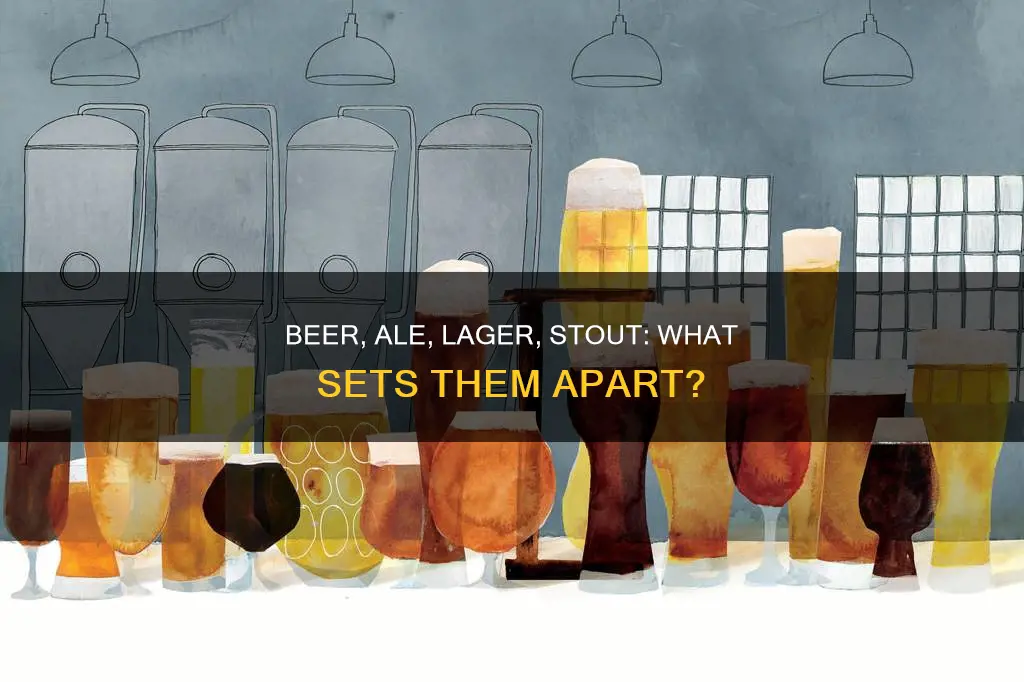
Beer is one of the world's oldest drinks, with the first barley beer production dating back to the Sumerians around 4,000 BCE. While there are many different types of beer, they can be broken down into two main categories: lagers and ales. The two key differences between these major classifications are the type of yeast used and the fermentation process. Ales are top-fermented at warm temperatures, while lagers are bottom-fermented at cold temperatures. Lagers are also known to be less expensive to make and are the dominant global style of beer. However, craft breweries tend to favour ales as they are cheaper to produce.
What You'll Learn
- Ales are fermented with top-fermenting yeast at warm temperatures
- Lagers are fermented with bottom-fermenting yeast at cold temperatures
- Stouts are dark, roasted ales with a bitter coffee taste
- Porters are dark ales with a roasted malt aroma and notes
- Pilsners are a subspecies of lager with a dry, slightly bitter flavour

Ales are fermented with top-fermenting yeast at warm temperatures
Ales are distinct from other types of beer, such as lagers and stouts, primarily due to the fermentation process they undergo. Ales are produced through warm fermentation, typically within the temperature range of 15-24°C (59-75°F). This is notably warmer than the fermentation temperatures used for lagers. The key player in this process is a top-fermenting yeast known as Saccharomyces cerevisiae, often referred to simply as "ale yeast."
This yeast plays a crucial role in defining the characteristics of ale. During the fermentation process, the yeast consumes sugars present in the wort (the sugar-rich liquid extracted from the mashing process) and converts them into alcohol and carbon dioxide. Ale yeast is particularly effective at working within the warmer temperature range, actively fermenting the wort and producing a significant amount of ethanol. This yeast tends to rise to the surface during fermentation, creating a foamy head—a signature characteristic of ales.
The warm fermentation temperature encourages the yeast to work quickly and vigorously, typically resulting in a faster fermentation process compared to lagers. This warm fermentation also contributes to the development of certain flavor compounds. Ales often exhibit fruity, estery notes, which can range from subtle hints of apple or pear to more prominent flavors like banana or cherry, depending on the yeast strain and fermentation conditions.
Additionally, ales often possess a fuller body and a more complex flavor profile due to the presence of byproducts produced during warm fermentation. These byproducts can include higher alcohols, which contribute to a fuller mouthfeel, and a range of esters that provide the characteristic fruity notes. The choice of yeast strain also plays a significant role in the final flavor and aroma characteristics of the ale, with different strains offering varying levels of fruitiness, flocculation (yeast clumping), and attenuation (sugar consumption).
Stout vs Beer: What's the Difference?
You may want to see also

Lagers are fermented with bottom-fermenting yeast at cold temperatures
The world of beer can be broadly divided into two categories: ales and lagers. While there are many variables in beer-making, the functional difference between the two lies in the strain of yeast used and the temperature at which the yeast is applied.
The process of bottom fermentation involves using yeast strains that work effectively at lower temperatures, causing the yeast to work less vigorously and create carbon dioxide more slowly. This results in less turbulence in the beer and yeast precipitating early in its life cycle. The cold temperatures of bottom fermentation require longer fermentation times, often 10 to 14 days, as the lower temperatures slow down the rate at which the yeast consumes sugars in the beer.
Lager yeast is a hybrid of Saccharomyces cerevisiae and a wild yeast from Patagonia called Saccharomyces eubayanus, which can thrive in much colder temperatures. The hybrid of these two yeasts, Saccharomyces pastorianus, inherited the ability to thrive in cold temperatures.
Lagers were originally fermented in caves during the cold months and consumed in the spring when the weather warmed up and the yeast had completed its job. This is why lagers are called lagers—the name comes from the German word "lagern", which means "to store".
Explore the Differences: Ale, Bitter, and Beer
You may want to see also

Stouts are dark, roasted ales with a bitter coffee taste
Stouts are part of the ale family and are known for their dark brown colour and thick texture. They are often compared to coffee and chocolate in terms of flavour, with a bitter coffee taste and hints of chocolate and toffee. The roasting process creates some of the same compounds in malt as in coffee or cacao, resulting in the coffee-like taste. Stouts are typically thicker than traditional ales due to the use of malt and smoked barley in the brewing process. The name "stout" comes from the word meaning "brave" or "strong", reflecting the bold dark taste of the beer.
Stouts have a rich history, originally becoming popular in the 1700s under the name "Porter". They were favoured for their cheap price, longevity, and ability to withstand changing temperatures. Over time, the brewing strengths increased, and the beer became available in varying ABVs. Even after the First World War, stouts remained a popular choice.
Today, stouts are widely available in over 120 countries and their brewing process has become a tourist attraction in cities like London and Ireland. While their popularity has waned, stouts remain a staple in many bars, pubs, and restaurants, offering a range of flavour types and strengths.
When it comes to serving, a tulip pint glass is recommended for a stout beer. The smaller gas bubbles of stouts are better retained in a shaped glass. The pouring process involves tilting the glass at a 45-degree angle and slowly pouring the beer into the middle of the pint to create a thick head.
Stouts stand out for their unique appearance, flavour, and history. They have evolved over the centuries, adapting to different tastes and preferences while retaining their distinct character.
Pilsner vs Lager Beer: What's the Difference?
You may want to see also

Porters are dark ales with a roasted malt aroma and notes
Porters are known for their deep ruby brown to black colour, with dark malts that impart chocolate and caramel flavours. They typically have a lower ABV than stouts, but this is not always the case. Porters are generally made from malted barley, while stouts are made from roasted, unmalted barley. Porters are also often described as having a "complex and flavorful dark malt character".
The two styles of beer, porter and stout, are closely related and have many similarities. The most noticeable similarity is their dark brown to black colour, which is often opaque but not cloudy. They usually have a pale malt base that is enhanced with dark malt, particularly crystal, chocolate, and black malts. Porters and stouts can also be brewed with adjuncts for additional flavour, such as chocolate, coffee, and vanilla.
The history of stout and porter is intertwined, and the terms are often used interchangeably today. The name "stout" was originally used for the strongest porters, and stout porter was later shortened to just "stout". Over time, brewers began to make porters stronger, or more stout, and stout became a distinct style of beer.
There are several variations of porters, including English porter or brown porter, which is the original style, ranging from medium-light brown to dark brown. Baltic porter is a strong European beer brewed with lager yeast and cold-fermented, almost black in colour. American porter is typically stronger than its English counterpart, with a nice balance of flavours. Robust porter is a very dark porter with fruity esters and more pronounced bitterness and roasted malt flavours.
Cask Ale and Beer: What's the Difference?
You may want to see also

Pilsners are a subspecies of lager with a dry, slightly bitter flavour
Pilsners are a type of lager with a unique flavour profile. They are a subspecies of lager with a dry, slightly bitter flavour. The first pilsner was produced in 1842 in the city of Plzeň in Bohemia (now the Czech Republic), and the style gets its name from this origin. Pilsners are known for their golden colour, bitter taste, excellent head retention, and floral hop aroma. They are light-bodied and highly attenuated lagers brewed from barley malt, with a delicate maltiness and a low alcohol content of around 4.5% to 5.5%.
The bitterness in pilsners comes from the use of hops, with German noble-type hops being a traditional variety used in European beers. The hop flavour is moderate yet obvious, added through a technique called late hopping, which also adds aroma to the beer. Pilsners have a variable hop profile, ranging from low to moderately high. Czech or Bohemian pilsners, for example, tend to be slightly darker and use Saaz hops, which impart a distinct spicy and floral aroma and flavour.
The malt used in pilsners provides a delicate maltiness and a sweet, malty residual aroma. Pilsner malt, a type of pale lager malt made from two-row spring barley, lends a sweet and bready or biscuity flavour to the beer. The balance between the malt and hop flavours is what makes pilsners unique.
In terms of mouthfeel, pilsners generally have a medium or soft body with moderate to high carbonation levels. The carbonation creates the impression of a lighter-bodied beer and contributes to the dry, crisp, and bitter finish. Overall, pilsners are well-attenuated, dry, and crisp, with a short finish of less than 15 seconds.
Doppelbock vs. Bock Beer: Historical Differences Explained
You may want to see also
Frequently asked questions
Ales are fermented with top-fermenting yeast at warm temperatures (60˚–70˚F), and lagers are fermented with bottom-fermenting yeast at cold temperatures (35˚˚–50˚F).
Stouts, IPAs, and saisons are all types of ales.
Budweiser and Miller Light are popular lagers.
Stouts and porters are both dark, roasted ales. However, stouts are less sweet than porters and often have a bitter coffee taste.
Pilsners are a subspecies of lager, distinguished by their water, which varies from neutral to hard. They are among the hoppiest lagers and tend to have a dry, slightly bitter flavour.







